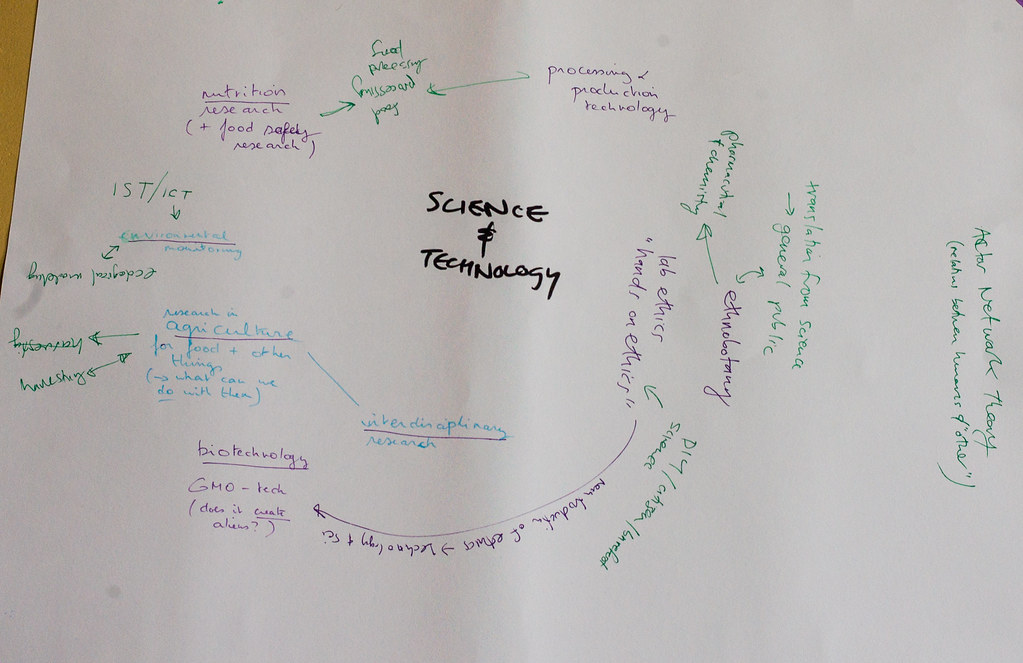Table of Contents
Human Invasive Interaction
Notes from scenario building session about the interaction between humans and invasive species. The two hour long workshop was designed to get a sense of what possible futures might exist for cohabitation with exotic and invasive species. Lisa Ma (a speculative designer working on 'human-invasives-interaction' at the time of the workshop) provided the framing and focal issue for the workshop. She was curious how invasive species might become a source rather than be seen as waste. Eva de Groote from Timelab brought together a diverse group of participants - from researchers, to activists, policy makers and cooks. The cultural centre Vooruit hosted the workshop at their premises and within their festival appropriately entitled “Possible Futures”. The workshop was an exploratory taste of Lisa's speculative microresidency at FoAM in 2014.
In collaboration with Timelab (Eva de Groote) andLisa Ma, at the Possible Futures Festival of Vooruit in Ghent, Belgium. Facilitated by Maja Kuzmanovic and Nik Gaffney (FoAM). Participants: Peter Goethals, Lucie Evers, Tobias leenaert, Tim Joye, Jan Seys, Lut de Clercq, Katrien Strubbe, Geert Heyeman, Paul Blondeel, Gino Pauwels, Bram Crevits, Ilse Dehondt, Tineke Janssens, Eva Peeters, Eva de Groote, Lisa Ma. Photos by Michiel Devijver (photos with people) and Nik Gaffney (photos of writing).
overview
Invasive and exotic species can be seen as opportunistic. They exploit ecological niches with brutal efficiency, spreading wherever they can. We could see them as extremely successful and adaptive plants and animals, but in most cases they are considered as a threat and a pest. A pest needs to be controlled, or even better - completely eradicated. However, this strategy has rarely worked in the past, so a change of approach is needed. Letting go of the idea of controlling invasives and changing our relationship to them is what might make them a source rather than a threat. However, in order for this relationship to change, both personal and systemic fear of the “wild other” must be addressed. How can we begin seeing opportunities for invasive opportunitst? How do we get from controlling to using invasive species, moving from branding them as “bad” towards “useful”? Which technologies need developing to make use of inevitable encroach of the invasive species? How will the social and environmental systems change?
Are alien species welcome? How will invasive species become a source, rather than threat and waste?

workshop harvest
key factors
In order for alien (exotic, invasive) species to be welcome, there are a few key factors that would need to be fulfilled:
- We think differently: with clearer information less tinted by anxiety, the public opinion of alien species might begin to change. We have to begin thinking creatively, from a whole systems' perspective.
- Climate is changing: Climate change might make our environments less hospitable for some species and more for others. We have to be prepared to adapt to these changes. Creating protective environmental boundaries and thinking in edges rather than borders might help as well.
- Alien species support us: they should become a part of the solution dealing with issues of food safety. For that to happen both regulation and culture must change. If seen as able to increase local economic resilience, they might be seen as productive species that can be seen as providing nutrition (or other support) for humans and/or others. A development of an invasives market is likely.
- Alien species adapt to us: Not all exotic species are invasive. Some of them adopt a strategy of invisibility and non-disturbance. As long as they have no negative impact on their host habitats, they're considered “nice” and likeable. We can help alien species willing to adapt and “do no harm” and find a way to use more aggressive invaders without fearing them.
drivers of change
Some of the current social, political, environmental, economic and technological trends might pull our relationship to alien species in different directions:
- Global tourism and (illegal, unconscious) import of alien species
- Asian trends (a.o. eating nearly everything that moves or grows and isn't poisonous)
- Public understanding of science and a rise of citizen science
- Emerging markets for new products and services
- Economic crisis and rupture
- Advances in ethnobotany
- Communication technologies used in environmental protection
- Actor network theory might help with seeing alien species as a part of a larger whole
- Food security is becoming a worry
- Cultural blending might extend to non-human species
- Climate change is forcing us to change our ideas of environmental stability
- …

society and culture

environmental and economic

science and technology
critical uncertainties
Out of key factors and macro trends, 6 critical uncertainties were chosen. Factors that are crucial for a successful cohabitation with aliens, but that are far from certain:
- Change of ethics is needed (from a disenfranchised, one-dimensional, disconnected “me” ethics, to a more conscientious, inclusive ethics and empathy with all living beings)
- Change of consumption paradigms (departing the status quo and changing behavioural patterns of consumers.
- Fundamental and applied research in interdisciplinary fields
- New business models to include aliens as productive species
- Storytelling (to decriminalise alien species)
scenarios
Two critical uncertainties were chosen as scenario axes:
- “Me” ethics ↔ Inclusive ethics
- Consumerist status quo ↔ Changing consumption patterns
Four scenarios for the year 2023, describing possible futures for cohabitation with alien species:


